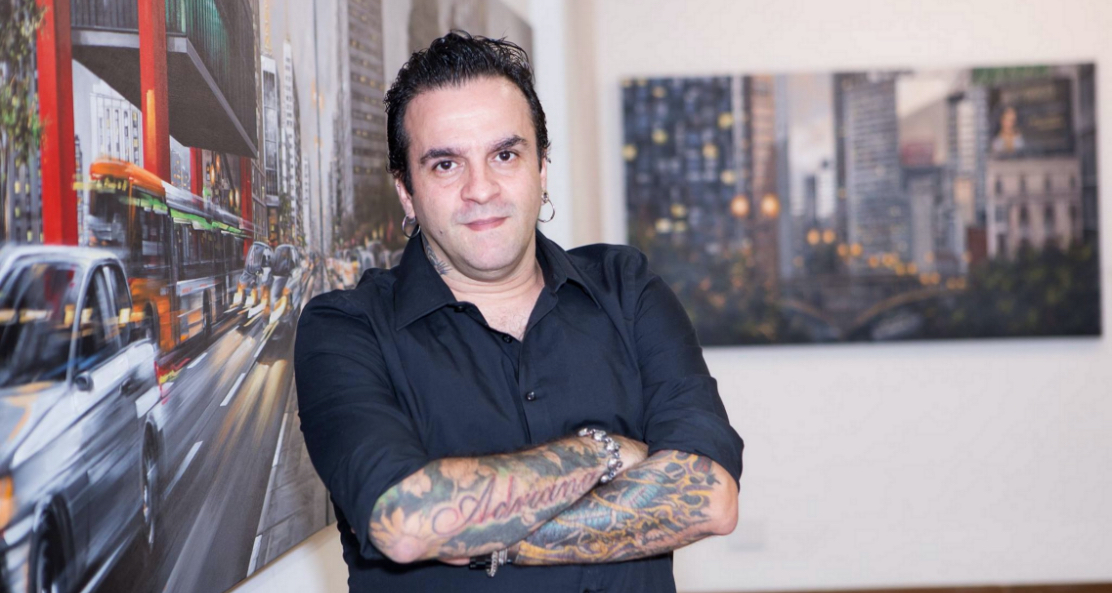Sophie Sadler meets the famous Brazilian artist who has just moved to Lagos and discovered how art saved him from dyslexia.
The walls of the Centro Cultural do Lagos, are graced with the repertoire of Maramgoní (born Waldemar Marangoni Jùnior) until 9 October, with a free exhibition of his work. This charismatic artist has recently moved to Lagos from São Paulo where his story began.
Born in 1972, the son of Waldemar Maramgoní and Maria Lúcia, Maramgoní Jnr was brought up amidst the packed skyscrapers of the hot and dusty city. What intrigues me about his work is, therefore, the way his cityscapes exude beauty and light, drawing you into the complexity of his depictions of the panorama.
Marangoni started painting at nine and displayed two excellent skills, visual and sound. His paintings showed great ability with the distribution of colour and light, and he was able to play any instrument just by listening.
As a teenager, his teachers thought him lazy and disinterested in his studies, but he adopted the stage name Maramgoní for his artistic endeavours.
He liked and had a talent for drawing and painting, so much so that he started teaching art at the age of 15. He did not lack students either, earning enough to buy paint, brushes and canvases, to pay his bills and to help at home. The once-troubled boy began to show a unique talent as an artist and at the same time formed his first heavy metal band called Evil Minds.
By the time he was diagnosed as dyslexic, he was already an adult. He was unable to acquire any knowledge through reading and so never studied the academic understanding of painting and was self-taught. Attracted by the concepts of light, shadow and dialogue between colours, he mastered the techniques of style through his eyes.
In his book, Maramgoni says: “I’m dyslexic, I can not think in the traditional way, I can not learn like everyone else. To give you an idea, I failed eight times at school and ended up giving up conventional study. If it was not for art, I do not know what I would be”.
The importance placed on his dyslexia as being the cornerstone of his artistic genius is reflected at LAC with a video presentation. The President of the Brasilian Association of Dyslexia explains what the world is like for sufferers.
The author of Maramgoní´s book, Marcio Pitliuk, explains: “The way Maramgoní paints is amazing. How can he portray urban landscapes that depend on perspectives and proportions, without tracing the lines that define these geometric calculations? It seems to have no explanation, but he finds one”.
His charming and devoted wife Adriana, who also acts as his public relations assistant, tells me when Maramgoni starts to paint, he works for 18 hours a day. “Sometimes without stopping to eat,” she adds. “And he completes a canvas in around four days.”
Maramgoni met the impressionist master Renato Pinto, who became his teacher for three months. He was invited to become Pingo’s assistant; however, after a few years, Maramgoní became dissatisfied with his work and felt the need to break down barriers and seek new lines.
The artist then focused on another field of research in architecture. The first-floor display of his work shows his discovery of Greco-Roman designs. He was helped in his growth by his contemporary art master Sérgio Longo, who assisted him in the most challenging part of his career.
Maramgoní then embarked on a series of works depicting São Paulo in the 19th Century. Studies on the famous sights of the city, which embody his love of the metropolis and invite us to reflect on the importance of keeping history alive.
Another area of his life where he re-ignited history was his relationship with Adriana. They were each other’s first girlfriend and boyfriend at the tender ages of 11 and 13, while their respective grandparents were neighbours. They lost touch and Adriana moved to London where she married and had a son and Maramgoní also married in Brazil. After their marriages ended, they met again 17 years later and have now been married for 18 years. They moved to Lagos to give security to their four-year-old son, having friends in the area and wishing to enjoy a similar climate to Brazil.
Maramgoní’s more opulent paintings, such as his depiction of Monaco, show us the reality of urban spaces in the modern day, described by Marcio Pitliuk as “a magical universe ruled by light and colour”.
In the master’s own words: “More than discussing art, the artist needs to have involvement with what he does, especially in the aspect of seeking a technical improvement and a line of work that satisfies him as aesthetic research.”
I am left rather in awe of this genius, with a mind that works in mysterious and complex ways. He claims art saved him or did he save art?
+INFO:
artinspirada.com
www.cm-lagos.pt
Facebook:@maramgoni

















